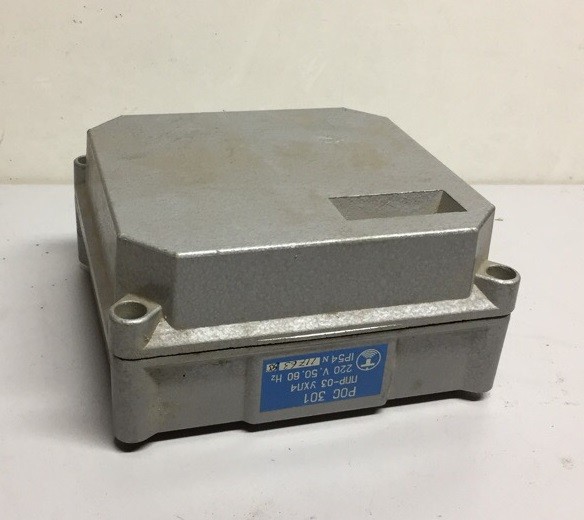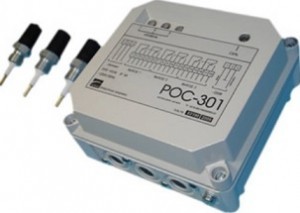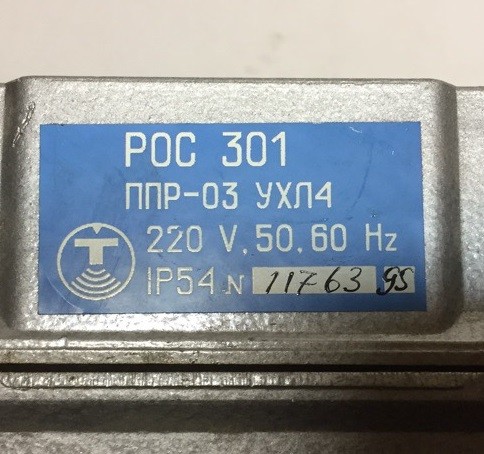Level sensor ROS-301 (PPR-03 UHL4)
ROS-301 level sensors-relays comply with TU-4218-003-14061525-2009 and are designed to control three levels of electrically conductive liquids through three independent channels in one or in different tanks in stationary and ship conditions outside hazardous areas. The principle of operation of ROS-301 is based on converting the change in electrical resistance between the electrode and the tank wall into an electrical relay signal. When the sensor electrode is immersed in the controlled environment, the resistance decreases (Rcp <5000 Ohm), the relay is activated and the LED of the corresponding channel lights up. In the absence of medium, the resistance increases (Rcp> 5000 Ohm), the relay is released and the LED goes out. ROS-301 has three independent channels that allow you to control 3 levels of liquid in one or different tanks. ROS-301 technical characteristics Design of sensitive elements: - rod; - cable. The length of the sensing element is from 0.1 to 2.5 m (up to 5 m can be ordered), the cable length is from 1 to 22 m. Supply voltage: - 220 V (+ 10% / - 15%), frequency 50 Hz ± 2% or 50 Hz ± 5% for OM version. The temperature of the controlled environment is from minus 100 to plus 450 ° С (depending on the design). Output signal: - relay; - light indication. AC voltage, V: 220, 380 frequency, Hz: 50 Power consumption, no more, V A: 7 AC voltage at the sensor electrodes, no more, V: 6 Load on the output relay contacts: current from 0.5 to 2.5A with a frequency of 50, 60 Hz, an increase in current up to 5A for a time of not more than 0.1C is allowed; voltage from 12 to 250 V. The upper value of the response resistance (liquid resistance between the electrode and the sensor body, at which the output relay is activated): 5000 Ohm Ambient temperature, ° C: for the sensor - from -50 to +70 for the transmitting transducer - +1 to +35 Relative humidity 80% at 25 ° C (non-condensing) for the transmitter and 100% at 25 ° C (with condensation) for the sensor. According to the degree of protection ros301 against dust and water, it corresponds to IP54 according to GOST 14254-80. Weight, no more, kg: transmitting transducer - 2 sensors - 0.65 ROS 301 installation conditions Installation and mounting of the ROS-301 sensor should be carried out in accordance with the technical description or the operating manual. Installation of connecting wires or cables is carried out with any wire or cable with a conductor cross-section of not more than 1.5 mm The connection of the primary and transmitting converters is carried out by a communication line of any length within the object (optimally up to 500 m.) Permissible value of the parameters of the communication line between the primary and transmitting converters of devices explosion-proof design: - capacities - 0.15 μF; - inductance - 0.2 mH; When installing ROS-301 explosion-proof sensors-relays, external intrinsically safe and intrinsically safe circuits must be laid with separate cables or wires. The distance between insulated wires of intrinsically safe and non-sparking circuits inside the transmitting converter must be at least 6 mm. It is allowed to lay communication lines between the primary and transmitting converters of the group of primary converters in one cable or bundle without screening the communication line of each of the primary converters. Under conditions of exposure to electromagnetic interference, the laying of communication lines between the primary and transmitting converters of one or a group of primary converters should be carried out in a screen or metal pipe. The transmitting converter ROS-301 is installed in a place convenient for monitoring the state of the glow of the light indication elements, for carrying out inter-routine maintenance. The primary transducer is installed on a container with a controlled medium horizontally, vertically or obliquely so that the controlled level is in the working area (within the control range) of the sensitive element. It is not allowed to install the primary converters so that the working zones (control range) of the level sensor's sensitive elements are located in places where constant occurrence of the controlled environment and the formation of air jams are possible. The primary transducer ROS-301 with a rod sensitive element is installed on the wall or cover of the tank so that the end of the thread is recessed by no more than 20 mm. It is allowed to place a part of the rope sensitive element in a pipe section with a diameter of at least 45 mm. If the length of the sensitive element is up to 2.5 m, the length of the pipe section should be no more than 250 mm; if the length of the sensitive element is over 2.5 m, the length of the pipe section should be no more than 600 mm. For vertical installation of primary transducers over 0.6 m long on a tank with intensive liquid movement, it is necessary to fix the end of the sensitive element through an insulator, or place it in a perforated metal pipe with a diameter of at least 80 mm. Controlled media reservoir, primary head must be grounded. When installing the primary converter POC 301 on tanks made of non-conductive material, it is necessary to provide an additional electrode inside the tank. For example, a perforated pipe with a diameter of at least 80 mm around the sensing element, a metal strip or plate. The additional electrode must be grounded and connected to the nozzle (flange) of the sensing element.
Вы можете заказать и приобрести «Датчик-реле уровня РОС-301» в розницу и оптом. Сделайте заказ, а мы доставим в города: Москва, Санкт-Петербург (СПб), Астрахань, Владивосток, Волгоград, Иркутск, Казань, Калининград, Красноярск, Магадан, Мурманск, Нижний Новгород, Новороссийск, Петропавловск-Камчатский, Ростов-на-Дону, Севастополь, Тюмень, Хабаровск, Чита, Якутск и по всей России.



